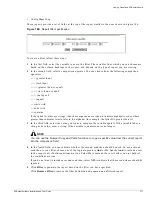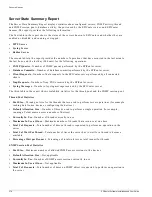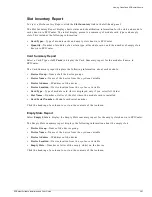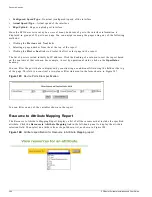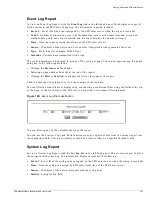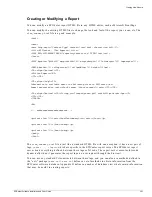
390
EPICenter Software Installation and User Guide
Dynamic Reports
All the files needed to create or modify reports can be found in the directory
<
epicenter_install_dir
>/user/reports
, where
<
epicenter_install_dir
>
is the directory where
the EPICenter software resides (by default
c:/Program Files/Extreme Networks/EPICenter 4.1)
in the Windows operating environment, or
/opt/extreme/epc4_1
on a Solaris system). There are two
subdirectories under the
reports
directory:
•
The
html
directory contains the HTML files displayed by the EPICenter server. The HTML files in
the reports directory have the following functions:
—
index.html
sets up the various frames for the browser display. It references
menu.html
to define
the menu on the left-hand side, and
body.html
for the content in the main panel of the window.
—
menu.html
defines the menu items for the predefined reports, and includes links to the html files
that generate the reports. This is a generated file. You can use this file in a customized report, but
it is not user-modifiable.
—
body.html
defines the content that appears in the main panel of the window when the Reports
feature is requested, either from the EPICenter software Start-up window, or from the icon on the
Navigation Toolbar. Modify this file if you want to change or add to the list of Reports and their
descriptions.
—
color1.html
defines the color of the bar at the top of the main content window. This is a
generated file. You can use this file in a customized report, but it is not user-modifiable.
—
epistylesheet.css
contains the style definitions used in the menu and main body frames.
—
reportstylesheet.css
contains the style definitions used in the reports themselves. To change
the look of all reports, you can modify this stylesheet.
—
The remaining files, such as
device_summary.html
, and
vlan_summary.html
, define a number of
the actual reports available from the Reports module.
Note that some of the reports (the Interface Report and the four Log reports) are not
user-modifiable, and are not included in the HTML directory.
•
The
tcl
directory contains the following:
—
The Tcl methods available for creating new reports
—
The source code for the existing reports
The information presented in the remainder of this chapter assumes you have a reasonably thorough
understanding of both HTML and Tcl scripting.
Summary of Contents for EPICenter 4.1
Page 20: ...20 EPICenter Software Installation and User Guide Preface ...
Page 46: ...46 EPICenter Software Installation and User Guide EPICenter and Policy Manager Overview ...
Page 190: ...190 EPICenter Software Installation and User Guide Configuration Manager ...
Page 204: ...204 EPICenter Software Installation and User Guide Using the Interactive Telnet Application ...
Page 242: ...242 EPICenter Software Installation and User Guide Using the IP MAC Address Finder ...
Page 266: ...266 EPICenter Software Installation and User Guide Using ExtremeView ...
Page 284: ...284 EPICenter Software Installation and User Guide Real Time Statistics ...
Page 436: ...436 EPICenter Software Installation and User Guide Using the Policy Manager ...
Page 454: ...454 EPICenter Software Installation and User Guide The ACL Viewer ...
Page 468: ...468 EPICenter Software Installation and User Guide Troubleshooting ...
Page 504: ...504 EPICenter Software Installation and User Guide EPICenter External Access Protocol ...
Page 510: ...510 EPICenter Software Installation and User Guide EPICenter Database Views ...
Page 522: ...522 EPICenter Software Installation and User Guide EPICenter Backup ...
Page 526: ...526 EPICenter Software Installation and User Guide Dynamic Link Context System DLCS ...
Page 546: ......


